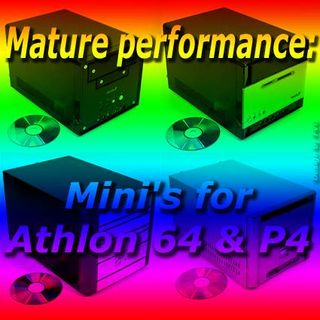PC Size Means Everything
Bare-bones Models From Biostar, Shuttle And Soltek

Slowly but surely, compact PC systems are establishing themselves in the marketplace. You will stumble across bare-bones models in many places, particularly those of the XPC series of Shuttle, which will even do justice for power-hungry, 3D games. Rumor has it that compact PCs have even shown up at several LAN parties. The situation is enough to show that minis are on the market to stay: Almost every motherboard manufacturer offers a corresponding bare-bones system - see the table below - that on request can be fitted out to become a powerful PC.
The Shuttle company probably takes the lead in this market segment: Almost two years ago the first bare-bones system, the SV25, appeared (see the article, Build Your Own Mini-PC For The Office ) based on Socket 370 (Intel Pentium III/Celeron). This was followed by a Socket 462 version (AMD Athlon XP - see the article, Goodbye to Hulking PCs: Athlon Mini-PCs Set The Trend ), and later there was the XPC series for P4 and Socket 478 (see the article, Whoohoo! A Mini PC That Goes To The Max ).
| Abit | DigiDice |
| Asus | Pundit, Prodigy, Terminator |
| Epox | eX5 Mini Me series |
| Gigabyte | SA series, TA series |
| Jetway | MiniQ 450 |
| MSI | Mega PC, Hetis, Hermes, Metis |
| Shuttle | XPC series |
| Soltek | QBIC EQ2000/3000/3401/3701 |
| Soyo | Mini Dragon, Dragon Gaming |

Compact & elegant: Mini PC's are especially good for individualists who care about good design and small dimensions
While the first systems had to make do with slow onboard graphics and still took second place in performance behind desktops, the current offerings show a clear trend: Compact dimensions notwithstanding, installing the appropriate components will achieve the same level of performance. However, visual appearance, including the features and functions offered, are the selling points of a bare-bones system, not system performance. While "big" desktops have steel cases, almost all manufacturers of bare-bones systems rely on lightweight aluminum. Lately there has been an increased trend towards front panels of brushed aluminum. The buttons and LEDs are also tastefully integrated into this, and in the appropriate color to boot. What purchasers of mini-PCs prize above all is the visual attractiveness of a bare-bones model. Your average off-the-rack desktop, on the other hand, is built to a run-of-the-mill pattern. And what is the interface like? High-speed interfaces for communication via USB 2.0, FireWire or serial ATA are now the standard. But the customer can also expect connections for network or 6-channel audio (analog or digital). In the current comparison, Shuttle even goes one step farther and integrates WLAN (802.11b) into the XPC SB65G2 for the P4 platform.
An absolute highlight of this comparison is the first mini-PC for Athlon 64 (Socket 754 platform): Based on the Nvidia NForce-3/150 chipset, the user can already rely on AMD's cutting-edge 64 bit technology. Thanks to its placement, the bare-bones system is also suitable as the basis for setting up a powerful gaming platform. Who else can offer this degree of performance in such a small package?
Stay on the Cutting Edge
Join the experts who read Tom's Hardware for the inside track on enthusiast PC tech news — and have for over 25 years. We'll send breaking news and in-depth reviews of CPUs, GPUs, AI, maker hardware and more straight to your inbox.
Current page: Bare-bones Models From Biostar, Shuttle And Soltek
Next Page Increasing Trend: High-quality Workmanship And Good Looks TooMost Popular


